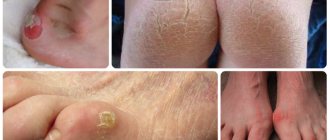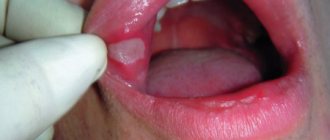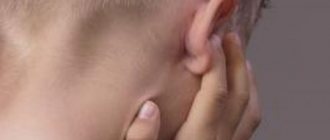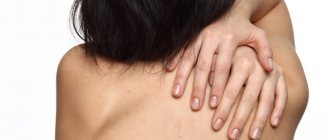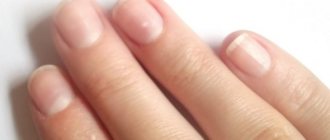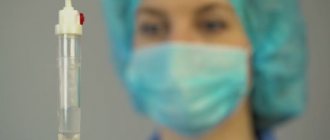The manifestation of unpleasant symptoms on the skin is very often the result of damage by skin mites. This type of disease greatly worries many people who have encountered this type of tick. Skin mites on the face cause especially a lot of discomfort.
Infection occurs very quickly and spreads throughout the entire face, including the hair growth area. A large number of external environmental factors and problems with the functioning of internal organs can lead to the appearance of this type of skin disease.
Skin mites do not disappear on their own; eliminating them requires the use of special medications and timely examination. If left untreated, the condition may deteriorate and a large area of the body may be affected.
What is demodex?
The appearance of skin mites is referred to in medicine as demodex. It is impossible to see such an organism with the naked eye; the skin mite is microscopic in size and is most often localized in the face, neck, chest and shoulders.
Features of Demodex:
- The largest number of skin mites is found in the sebaceous glands;
- In humans, skin mites can live for a long time in the upper layers of the skin and not cause any unpleasant symptoms;
- After weakening of the immune system or in the event of a violation of the protective functions of the skin, the tick has the ability to penetrate into the deep layers and form purulent, inflamed formations;
- Women most often suffer from this type of skin disease;
- To identify the type of disease, it is necessary to undergo a special type of diagnosis, during which the source of unpleasant symptoms will be identified.
Externally on the skin, a skin mite most often appears in the form of pimples with the presence of pus or subcutaneous nodules, which after some time become inflamed and increase in size.
What does a tick look like?
Examining the components of inflamed formations under a microscope, you can see:
- The demodex mite is a type of glandular acne, the reproduction of which occurs in the sebaceous glands;
- Outwardly it resembles a thin transparent worm;
- The tick's shell has no color, but is dense;
- The size of the tick is on average 0.4 mm;
- The skin mite moves with the help of scales;
- Demodex feeds on skin cells and subcutaneous fat.
Demodex most often exhibits its activity at night or during the development of diseases that reduce immunity.
Epidemiology of demodicosis
Source of infection
The main source of demodex mites are sick people or carriers.
Distribution routes
- Iron mites can be transmitted through bedding, underwear, and personal items. The parasites were found in house dust, the source of which was bedding.
- Some researchers suggest that ticks can get on a child during breastfeeding from a sick mother.
Sustainability
Constant humidity, darkness and air temperature within 30-40°C are optimal conditions for iron mites. Outside the host, at room temperature, constant humidity and in the dark, ticks live up to 9 days.
According to the observation of some researchers, parasites remain viable in water for 7 days, and up to 2 weeks in immersion oil.
Rice. 6. Demodex mite under a microscope.
How the disease develops
Demodicosis in humans can develop for the first time and occur as an independent disease, or develop against the background of existing skin diseases (acne, perioral dermatitis, rosacea, seborrheic dermatitis, etc.). From 55 to 100% of the population are carriers of iron ticks and do not have any manifestations of the disease, which proves that the parasites belong to the opportunistic flora. Damage to follicles by parasites increases with age.
Factors in the development of the disease
Acne iron mites are an opportunistic infection. They can parasitize a person for many years without causing him any harm. Their activation and active reproduction depends on a number of factors.
- Changes in microbiocenosis, the function of the sebaceous glands and the composition of sebum are the trigger mechanism of the disease. Changes in the composition of surface lipids lead to the development of dysbiosis.
- Demodex mites are carriers of viruses and microbes into the sebaceous glands and hair follicles. When pathogenic pyococci and fungi Pityrosporum spp are introduced, purulent-necrotic inflammation develops.
- The bacillus Bacilluss oleronius found on the surface of the parasite increases the activity of ticks and stimulates staphylococci, streptococci, acne propionobacteria, and fungi of the genus Malassezia to produce anti-inflammatory proteins, which triggers a cascade of immune reactions.
- The presence of foci of chronic infection, disturbances in the functioning of the liver and gastrointestinal tract, endocrine glands, nervous system, and corticosteroid therapy contribute to the activation of ticks.
- The rise in incidence in the spring-summer period is associated with increased insolation. An increase in the production of vitamin D under the influence of ultraviolet radiation leads to an increase in the synthesis of cathelicidins, which support the inflammatory process.
- The likelihood of infestation by Demodex mites increases in individuals with a sharply reduced functioning of the immune system, which occurs with primary and secondary immunodeficiencies, long-term use of corticosteroids and cytotoxic therapy, HIV infection, leukemia, T-cell lymphoma and other malignant neoplasms.
- The mite infestation maintains the activity of the existing inflammatory process. An imbalance in the cytokine cascade develops when the immune response is too strong.
Mechanisms of action of iron mites on humans
The impact of Demodex mites on humans is multifaceted:
- When feeding, the parasites secrete aggressive saliva and mechanically destroy the cell walls of the sebaceous glands and follicles, inflammatory infiltrates and granulomas form in the dermis, and the processes of keratinization and pigmentation develop.
- Substances formed after the death of ticks have antigenic properties, which leads to allergization and increased immune response.
- When the immune system is suppressed, opportunistic flora is activated, which successfully colonizes the host.
Acne iron mites act as carriers of bacteria and viruses, which complicates the course of demodicosis and complicates treatment.
Rice. 7. Histological preparation of a skin section. Arrows indicate the location of demodex mites.
Source and causes of occurrence
The mite can live on the skin and hair of almost every second person.
However, under normal conditions of functioning of internal organs, further spread of the tick does not occur. This disease is also called demodicosis.
The causes of the disease are as follows:
- Disruption of the digestive organs;
- Frequent nervous breakdowns;
- Insufficient or excessive skin care;
- Incorrectly selected cosmetics;
- Excessive use of saunas and solariums;
- Excessive coffee consumption and bad habits;
- Spicy food;
- Decreased functioning of the endocrine gland.
You can also become infected with a tick through close contact with a sick person, for example, sharing a bed or sharing cosmetics. The disease cannot be transmitted by air or other types of contact.
Secondary demodicosis
Secondary demodicosis develops against the background of diseases accompanied by a sharp suppression of the immune system (HIV infection, leukemia, etc.), long-term use of corticosteroids and cytotoxic therapy, or develops against the background of acne and rosacea, complicating their course. This form of the disease is registered in 33% of patients with acne.
Secondary demodicosis is characterized by:
- the disease appears at any age;
- lesions are widespread;
- presence of anamnesis and clinical picture of relevant diseases.
Papulopustular rashes on the skin of the face are a reason for diagnosing demodicosis.
Rice. 8. Demodectic mange on a woman’s face.
Signs and symptoms of the disease
Very often, mite infestation is confused with acne and the correct treatment is not used.
Demodex manifests itself with the following first signs:
- The skin becomes oilier and visual enlargement of pores is observed;
- Formation of places on the skin with an increased level of shine;
- Redness and swelling of the skin;
- Itching at night;
- The appearance of scales on the eyelashes, which can lead to burning and itching.
After infection, the following unpleasant symptoms occur:
- Inflammation and swelling of certain areas of the skin;
- The appearance of red bumps;
- Hair loss and itching on the scalp;
- The appearance of pimples in large numbers with purulent inclusions;
- Puffiness of the eyes;
- Formation of ulcers;
- The appearance of plaque in the area of hair growth.
Symptoms may appear in isolated cases or with a high level of distribution in healthy areas of the skin.
Manifestations of demodicosis in various parts of the body
The eyelids and eyes are quite often affected by this disease, since mites reproduce in the meibomian glands, which are located at the base of the eyelashes. If treatment is delayed, eyelashes may fall out, as well as an increase in the edges of the eyelids, which leads to difficulty closing the eyelids.
Interesting fact! When the eyelids are affected, in many cases demodicosis appears on the scalp, as well as on the face, which causes chronic conjunctivitis, abnormal eyelash growth and other pathologies.
Demodicosis of the scalp occurs due to favorable conditions. It is not easy to identify, since negative processes are hidden under a person’s hair and visually occur unnoticed. At the same time, in the evening and at night, severe itching is felt, and as a result of palpation of the scalp, thickening of the skin can be felt.
As a result of the active reproduction of parasites, the disease spreads to areas of the body such as the neck, chest, back or arms. Damage to these areas of the body is accompanied by sensations of itching, skin tightening and burning. In fact, this is a rare occurrence, since the structure and functioning of the sebaceous glands in such areas are somewhat different, so the mites do not feel entirely comfortable here, but due to the large number, they simply have nowhere to go.
Stages of development
Depending on the number of mites and the degree of their progression in the deep layers of the epidermis, different stages of the disease are distinguished.
Such as:
- The prodromal stage is the first stage when a tick infection has just occurred. During this period, practically no unpleasant symptoms are felt; the disease can only be identified using special diagnostic methods. This period is considered the most optimal for the complete elimination of the skin disease. The very first symptoms are slight redness of the skin in the areas where the sebaceous glands are located;
- Erymatous stage - the disease begins to progress and a person can already visually observe the first visible symptoms, such as swelling and the formation of purulent pimples. This stage can be treated without the use of complex therapy;
- The papulopustular stage is a more complex stage of the development of the disease, which manifests itself in the form of a large number of pimples, accompanied by specific itching and inflammation of the skin. Treatment requires special examination and observation by the attending physician;
- The hypertrophic stage is considered the most complex course of the disease, which is manifested by large inflamed formations containing pus. At this stage, it is almost impossible to eliminate the disease.
To prevent the development of complex stages of the disease, it is recommended to seek help in a timely manner and not self-medicate.
Symptoms of demodicosis
External factors indicating the presence of this disease depend on how actively the parasites multiply, how strong the patient's immune system is, and what type of skin. People with oily skin are more at risk of developing this disease because their sebaceous glands are more active.
Common signs of demodicosis:
- The appearance of a rash on the skin, which indicates the presence of an inflammatory process. As a rule, the rash appears on the face, eyelids, and also on other parts of the body, but somewhat less frequently.
- The appearance of unbearable itching, especially in the evening hours, as well as at night, since parasites are afraid of light.
Demodicosis is classified in humans according to the ICD-10 code: B88.0 and is determined by external visual signs:
- The affected areas of the skin exhibit an erythematous form, which is characterized by redness of certain areas of the skin, such as the nose and cheeks, which are distinguished by clearly defined edges, somewhat raised. The formation of so-called “vascular spiders” from small vessels occurs. When the skin of the face is affected, they are clearly visible, especially on the sides of the nose and cheeks.
- The papular-pustular stage is characterized by the presence of pimples (papules) and ulcers (pustules) about 2 mm in size. This is due to the fact that they are formed as a result of the hair follicles overflowing with sebum, which, in turn, is associated with the overflow of the space with parasites that block the ducts. New growths differ in shades from pink to red-bluish.
- The hypertrophic stage is the result of lack of treatment. It is characterized by the appearance of hypertrophic areas of human skin, resembling pineal growths. Depending on the affected area, they have specific names.
It is important to know! Symptoms of demodicosis in children are often disguised as a rash that appears in adolescence due to hormonal changes in the body. In this case, it is better to contact a specialist to determine the presence or absence of ticks.
What triggers the growth of subcutaneous mites?
The following factors lead to the rapid growth and reproduction of ticks:
- Improper skin care;
- Insufficient intake of vitamins;
- Disease of internal organs;
- Lack of treatment for skin mites;
- Use of antibiotics;
- Dysbacteriosis;
- External negative factors.
In addition, increased activity of the sebaceous glands increases the growth of the mite, which can occur as a result of excessive use of products containing alcohol.
Localization of manifestations of demodex
Demodex on the face is localized mainly on the wings of the nose, nasolabial folds, and on the chin. Due to the frequency of manifestations on the face in these places, they are called the “demodex triangle”. On the head, eyelashes, scalp, ears, and neck are also affected. If the disease is significantly advanced and long-term, then manifestations of demodex may also appear on the chest and back (in rare cases).
It becomes clear that the demodex mite chooses to live in places where increased sebum secretion is possible on the skin, as well as in the hair follicles.
Diagnostics
To identify the stage of development, it is necessary to carry out special diagnostic methods:
- Scraping from the site of inflammation - using a scalpel, carefully take a scraping from the affected areas of the skin;
- Eyelash test - several eyelashes from both eyes are taken for analysis;
- Using adhesive tape , which is glued to the affected area for a certain time, after which it is checked for the presence of ticks.
After receiving the tests, the doctor prescribes the necessary treatment and diet to improve the general condition of the body.
Demodex analysis
To determine the presence of the parasite, a special skin analysis is done - scraping for demodex. The scraping procedure is completely painless, and it is simply necessary to undergo it, since manifestations similar to demodicosis occur in some other skin diseases (for example, rosacea or common acne). The similarity of such manifestations leads to the fact that people confuse these diseases when trying to use traditional remedies. As a result of improper treatment, demodicosis can become quite severe.
In modern laboratories, doctors will be able to not only determine the presence of demodex mites in the skin, but also its type. There are two such types: long and short demodex:
- The long Demodex mite (Demodex folliculorum longus) has an elongated, worm-like body. Its size reaches 0.480 mm. This type of mite lives in hair follicles.
- The short demodex mite (demodex folliculorum brevis) has a body length of up to 0.128 (in males) and up to 0.176 mm. (in females). Its habitat is the sebaceous glands.
It is important to determine the type of demodex, since the duration of treatment may depend on it.
How to get rid of subcutaneous mites?
To eliminate skin mites, it is recommended to use the following treatment methods:
- Medicinal treatment of the problem helps eliminate the disease and reduce unpleasant symptoms. Prescribed strictly by the attending physician depending on the degree of development of the disease;
- Cryotherapy - aimed at restoring cells that were damaged by the tick and blocking the further development of the disease;
- Following a special diet can improve the condition of the skin and increase immunity;
- Traditional medicine - the use of traditional medicine methods can reduce unpleasant symptoms and prevent further development of the disease.
Most often, to eliminate the disease, it is recommended to use complex therapy, which will not only eliminate the disease, but also reduce the manifestation of the consequences after the disease.
Drug treatment
To eliminate ticks by medication, the following types of medications are prescribed.
Antiparasitic drugs
Allows you to reduce the development of skin mites in the layers of the epidermis and improve the natural processes of cell regeneration.
The most popular of them:
- Metronidazole is a drug for external use prescribed to eliminate ticks. Apply twice a day directly to the affected areas. Used from 12 years of age, the course of treatment is prescribed individually for each patient. The cost of the ointment is 140 rubles ;
- Benzyl benzoate , a substance in solution form, is widely used to eliminate many types of epidermal diseases. Destroys the integrity of microorganism cells, thereby eliminating the mite. Apply twice a day to problem areas of the body. The course of treatment is no more than 21 days. Not applicable until age 10 years. Avoid contact with mucous membranes; it may cause a strong burning sensation. Average cost 60 rubles ;
- Sulfur ointment – improves skin condition, fights various types of skin parasites. Apply once a day before bedtime. It is recommended to rub the ointment until completely absorbed. Can be used from the age of 5 years. Cost 45 rubles .
Metronidazole
Benzyl benzoate
Sulfuric ointment
Antibiotics
Used for more complex types of disease development. Prescribed to block further spread of the disease and reduce recurrence.
The most effective antibiotics:
- Trichopolum - has a broad effect on the problem. Blocks the possibility of movement of parasites, thereby reducing their further reproduction. Use 1 tablet for 10 days. Prohibited during pregnancy, liver and kidney dysfunction. Cost 180 rubles ;
- Rozamet is a cream for external use that contains the antibiotic metronidazole and helps reduce the reproduction of the parasite. Use twice a day for a course of no more than 1 month. Contraindicated for pregnant women and under 12 years of age. Price 220 rubles ;
- Aversectin ointment - allows you to quickly eliminate the tick. Use once a day on damaged areas. The course of treatment is no more than 10 days. Use with caution for people with sensitive skin and during pregnancy. Has the property of causing side effects. Price 60 rubles .
Trichopolum
Rozamet
Aversectin ointment
Restorative products for the body
Aimed at strengthening the protective functions of the immune system and activating the body's natural fight processes.
Most prescribed drugs:
- Lykopid - used to enhance the functions of the immune system, used once a day for 15 days. Price 300 rubles ;
- Vitamin complexes - required to increase immune resistance to various types of diseases, such as fish oil and vitamin D, for example Aquadetrim with an average price of 180 rubles .
Lycopid
Aquadetrim
Vascular strengthening agents
Necessary for strengthening blood vessels that are damaged as a result of tick activity. They are prescribed individually for each patient, if the attending physician considers this type of medicinal substance necessary.
Correctly selected medications can quickly reduce unpleasant symptoms and improve the overall condition of the skin.
Treatment with folk remedies
To eliminate demodex in the first stages of its development, various traditional medicine methods are often used, which help get rid of symptoms and block further progression of the disease.
The most commonly used healthy home recipes are:
- Washing with laundry soap helps clean the skin and reduce the movement of the parasite. It is recommended to wash your face three times with laundry soap. Effective in complex therapy with other types of folk remedies. Appointed from the age of 4 years;
- Ointment with gunpowder - mix gunpowder and butter in equal proportions, apply the mixture twice to damaged areas. The course of treatment is no more than 14 days. Permissible age of use is from 12 years;
- Wormwood tincture – reduces tick activity and blocks its further reproduction. Pour boiling water over the dry herb and leave for 30 minutes. Drink half a glass daily before meals. The duration of treatment is no more than 15 days. Contraindicated for children and during pregnancy;
- Aloe – grind aloe, add crushed streptocide tablet. Apply the resulting mixture to the skin daily for 2 weeks. Used from the age of 5 years;
- Birch tar – mix sulfur powder and birch tar in equal proportions. Apply daily before bed and leave for several hours. After removal, wash with tar soap. It prevents further reproduction of demodex and destroys the integrity of its shell. The course of application is up to 14 days.
The use of such methods requires regularity; before use, it is necessary to conduct an individual sensitivity test.
Non-drug treatments
The following treatment methods are widely used to remove demodex.
Application of medicinal cosmetics
It is used for daily care and prevents the emergence of new mites, and also reduces the external manifestations of the disease.
The most popular means:
- Demoten is a specially developed gel for external use that allows it to penetrate deeply into the layers of the skin and destroy parasite cells. Suitable for daily use. Effectively moisturizes and nourishes the skin. Applicable from the age of 14 years;
- Demodex foot cosmetics series - specially developed products contain special components that effectively fight mites and reduce external manifestations. The line of cosmetics includes cream, shampoo, and tonic. Suitable for daily use from 14 years of age. Not used for people with hypersensitive skin and during pregnancy;
- The Demodex Complex line of products contains natural herbal ingredients. They are used at different stages of disease development. Suitable for daily use from the age of 18 years.
Demoten
Stop Demodex Demodex Complex
Deep peeling
Produced in special cosmetology rooms.
The procedure has the following features:
- Fruit acids are used as a basis , which reduce the production of sebaceous glands;
- This cleanses the skin of dead cells and prevents the spread of mites.
This method is considered most effective for the initial symptoms of the disease. Do not use in the presence of wounds and inflamed formations.
Darsonval procedure
Used to improve the natural processes of the skin.
The procedure has the following features:
- The supply of oxygen to the cells improves protective functions and prevents the further spread of demodex;
- Before carrying out the procedure, it is recommended to undergo appropriate diagnostics and consult a doctor;
- It is prohibited to use any preparations for external use for several days before the procedure;
- Prohibited for people with hypersensitive skin and people with pacemakers;
- Suitable for ages 12 and up.
The procedure is carried out using a special device that emits small currents that activate skin cells.
Cryomassage
Carry out using liquid nitrogen.
The procedure has the following features:
- Under the influence of low temperature, ticks freeze, which leads to their death;
- The use of cryoprocedures will reduce external symptoms;
- The procedures are carried out until the disease disappears completely;
- It is recommended to use in combination with drug therapy.
Before the procedure, it is recommended to remove all medications from the skin; cold exposure is performed for at least 3 minutes. Prohibited during pregnancy and for people under 14 years of age.
Laser removal
It is used after drug treatment and effectively reduces the external manifestations of the disease.
The procedure has the following features:
- Using a laser beam, damaged cells are aligned and removed;
- Applicable from the age of 18;
- It is prohibited if there are wounds or inflammation on the skin; you should consult a doctor before the procedure.
Physiotherapy
Used to remove skin mites.
Features of the procedures:
- Electrophoresis is most often used to improve the protective functions of the skin;
- Applications with medications are used;
- Can be used from the age of 12 years.
Experts recommend using comprehensive approaches to eliminate the problem, and to carry them out strictly in special institutions.
Methods for treating demodicosis in humans
Nowadays, you can count on effective treatment thanks to the availability of various effective medications. If the diagnosis is confirmed, the dermatologist determines a treatment regimen, which includes some steps, such as:
- The stage of using topical components such as ointments, creams, sprays, etc.
- The stage of using medications that improve the body's resistance.
- The stage of cleansing the gastrointestinal tract and the entire body of the patient from traces of parasite activity.
- The stage of using antibiotics and antiparasitic agents that kill ticks. Some drugs should not be used by expectant mothers and nursing women, people suffering from kidney disease, etc.
- The stage of using medications that relieve allergic symptoms.
- The stage of using antiseptics to protect the skin from other parasitic infections.
Treatment of demodicosis involves the use of systemic agents, such as:
- Immunomodulator drugs.
- Sodium thiosulfate, to kill mites and reduce inflammation.
- Vitamin complexes, amino acids and minerals, which increases the body's resistance.
Important point! Treatment of the skin is carried out in several stages. Depending on the extent of the damage, treatment can take up to a year. The most effective are ointments and creams that contain components containing zinc, mercury, tar, sulfur, etc. They do not allow oxygen to the affected area, which leads to suffocation of ticks and their death.
Effective medications include:
- Sulfur ointment.
- Ichthyol ointment.
- Yellow mercury ointment.
- Ointments based on metronidazole.
- Benzyl benzoate cream, which destroys parasites.
- Aerosol "Spregal", which leads to the death of adults and their eggs.
- Cosmetic product "Demalan", which reduces the level of inflammatory processes and improves the processes of regeneration and metabolism in the affected areas of the skin.
- The substance “Crotamiton”, which is used after taking a shower. Helps relieve itching and reduce inflammation, and also kills adults.
- Stop Demodex cosmetic gel helps reduce itching, localize swelling and inflammation in the eyes and eyelids. In addition, it helps get rid of ticks.
Removing toxins from the body
Cleansing the body is an important stage in the fight against demodicosis. During the treatment process, it is necessary to exclude sweet, fatty, smoked and fried foods from the diet. During this period, it is better to eat more fruits and vegetables, cereals, and drink a sufficient amount of liquid (up to 2 liters per day), which will optimize the body’s functioning and create uncomfortable living conditions for parasites.
Interesting to know! Cleansing the body and gastrointestinal tract is carried out with the help of absorbent drugs, such as Activated Carbon, Smecta, Enterosgel, Polysorb and others. They will help get rid of those substances in the body that parasites left behind.
Treatment of demodicosis with traditional methods
It is also possible to fight demodicosis with the help of traditional medicine, but again, treatment is carried out comprehensively, in several stages. At the initial stage, the functions of the immune system are restored, the next stage is the fight against ticks, and the final stage is the restoration of the functions of the skin of the affected areas.
The following plant infusions are recommended for internal use:
- Take 1 part each of leaves of plantain, wormwood, mint, yarrow, tansy inflorescences, string and nettle. Then take 2 tbsp. spoons of this mixture and pour 500 ml of boiling water. The product is infused for half an hour, under a tightly closed lid. Use half a tablespoon 3 times a day before meals for 4-6 weeks.
- Take 2 parts of violet, calendula flowers, St. John's wort, as well as 1 part of mint, plantain and elecampane root. Then take 2 tbsp. spoons of the mixture and pour half a liter of boiling water, after which the product should brew for about half an hour. Before use, strain and consume similarly.
- For external use, it is recommended to prepare the following compositions:
- Squeeze aloe juice and dilute it in water in a 1:1 ratio, then moisten a napkin with the solution and apply it to the affected area of skin for 15 minutes. It is necessary to carry out up to 25 similar procedures every other day.
- A decoction of linden inflorescences is prepared. For this, take 2 tbsp. spoons of raw materials and pour 1 glass of boiling water. The solution must be kept in a steam bath for about 10 minutes. After filtering the solution, wipe the affected areas of the skin with it 2 times a day. After completing the procedure, it is better not to go outside.
- For 20 days, compresses from the juice of ripened tomatoes are applied. The duration of the procedure is about 15 minutes.
- Take a couple of spoons of dry chamomile and pour 1 glass of boiling water, after which the solution can be boiled for about 10 minutes. Then the product is filtered and applied to the affected areas in the form of compresses. Hot and cold compresses should be alternated. The procedures are used up to 3 times a week.
- Take 1 tbsp. spoon of juniper berries and crushed, after which the berries are poured with 1 tbsp. boiling water and leave to infuse for up to 6 hours. The solution should be filtered before use. The product is used up to 2 times a day in the form of lotions. The duration of the procedure is up to 20 minutes. Before use, it is better to treat the affected areas with tincture of calendula or eucalyptus.
- Take 100 g of tansy inflorescences and infuse them in 400 ml of vegetable oil for 2 weeks. Before use, the mass is filtered and used in the form of warm compresses up to 2 times a day.
- Wormwood leaves are ground to a powdery state, after which 3 tbsp is taken. spoons and steams. After this, add 1 teaspoon of honey, 1 teaspoon of alum, 1 tbsp. a spoonful of vegetable oil and 2 tbsp. spoons of viburnum berries, which are crushed. All components are thoroughly mixed. It is used as follows: the ointment is applied to pieces of cotton fabric, and then applied to problem areas. The duration of the procedure is up to 2 hours. The number of procedures is no more than 2 times a day. Before use, problem areas should be wiped with a glycerin solution in a ratio of 1 teaspoon to 1 glass of water. After 2 hours, after removing the product, it is washed off with salt water at a concentration of half a teaspoon per 1 tbsp. water.
Recommendations and useful tips for treatment
To achieve more visible treatment results, dermatologists advise following the following recommendations:
- Cleanse the skin daily with special preparations that eliminate excessive oily sheen;
- Do not use hot water for washing , this procedure disrupts the natural protective functions of the skin;
- Reduce skin touching , especially in the facial area. A person’s hands may contain a large number of bacteria that contribute to the disruption of the structure of the skin and can cause the development of mites;
- Ensure the cleanliness of personal hygiene products and items for applying cosmetics;
- Avoid prolonged exposure to direct sunlight;
- Replace the feather pillow with padding polyester , very often down can cause a reaction and provoke the occurrence of demodex;
- Do not apply cosmetics in large quantities ; this method of applying cosmetics leads to clogged pores and the development of skin mites.
Experts recommend following such facial care methods even in the absence of tick infestation, as well as during treatment with medications.
What drugs are used in the treatment of demodicosis?
In order to rid the patient of this disease as quickly as possible, ophthalmologists prescribe many medications. One of the most popular among them is “Blefarogel”, developed on the basis of sulfur, which does an excellent job of eliminating mites and other parasites that “capture” the ducts of the sebaceous glands. The drug also contains hyaluronic acid, which promotes rapid healing of damaged tissue cells and increases the level of immune defense. In addition to Blefarogel, experts often prescribe the following drops:
- "Tobramycin";
- "Okomistin";
- "Albucid";
- "Carbohol";
- "Physostegmine."
This is not a complete list of existing drops that can be prescribed for the treatment of demodicosis. Quite often, medicinal ointments are used for these purposes. Their use is considered necessary in cases where the disease can be considered advanced, for example, when a rash appears on the face or the hair follicles are no longer affected. The most common ointments that are most often prescribed by specialists for this disease are:
- Sulfuric;
- Permethrin;
- Zinc;
- "Rozamet";
- "Benzyl benzoate".
Remember that in each specific case the treatment method is selected individually, so do not ignore visiting an ophthalmologist and make an appointment with him at the first feeling of discomfort.
Special diet
When dealing with demodex disease, experts often advise following a certain type of diet.
First of all, you should exclude:
- Salty food;
- Fatty foods;
- Fried and spicy foods;
- Smoked meats and sausages;
- Sweets;
- Canned and fatty meats.
During the treatment period, it is recommended to focus on the following fruits:
- Apples;
- Pears;
- Banana;
- Grapefruit (small quantity)
- Pomegranate;
- Kiwi.
Consumption of citrus fruits is not recommended, as this can contribute to the development of allergic reactions and aggravate the disease.
It is also recommended to introduce fermented milk products and whole grain cereals into the diet. Saturating the body with foods that contain fiber can reduce the deposition of toxins and wastes and improve natural metabolic processes.
Pharmacy skin rubs, recipes
Loshakova strongly recommends buying pharmacy wipes from this scheme from Igor Kirillovich, who rents a room on Belorusskaya and on Thursdays supplies all of Loshakova’s clients with ointments and rubs. The cost of a set of two rubs and ointment is 2000 rubles, and you need a “prescription” from the clinic.
The last time I came to Loshakova was in September to pick up a prescription for sulfur-salicylic lotion, I really like it for light peeling. But it was not possible to take normal prescriptions - the doctor does not have official forms for making rubs in the pharmacy. That is, in order to fill prescriptions in a pharmacy, you need to go to another dermatologist and ask to write out prescriptions. Nevertheless, I urgently took the “unofficial forms” from Loshakova.
But to save myself time, I went to Igor Kirillovich for ready-made rubs. They contain medicinal ether, which is prohibited for sale in pharmacies, and I don't know why, but maybe because of side effects. The rubs are now sold in plastic jars (they used to come in glass), which resulted in a quarter of it spilling in my car and making everything smell like ether.
Today I took a photo for this post and threw the wipes away out of harm's way. It is impossible to use them, the lids leak and the ether instantly fills the entire apartment with vapor.
Rub number 1
Rub number 2
Reviews
Reviews about the treatment of skin mites:
My personal opinion and reviews about the doctor Loshakova Valentina Ilyinichna
If I had seen this diagram in full already at the first consultation, I would never have carried out such treatment, especially since the doctor does not give any guarantees. But I liked the comment of one forum member in the topic to which I provided a link above:
This method is called eat all the anti-parasitic drugs in a row, overeat with vitamins, enzymes, drugs for the liver - maybe something will help, and drop everything you have into your eyes, and put everything in the pharmacy behind the lower eyelid - just in case. Well, apply all the anti-acne ointments to your face, burn your face with mash, and apply Contractubex too, maybe you’ll also remove the scars...
I have already touched on the topic of this treatment in a post about Yam Ointment and Demodex Tar. I followed all the recommendations for 7 months (but did not remove the cross), my skin became much better, it was almost completely renewed (but not quite perfect), and remained in this state for almost a year. But paying for health for just a year is too expensive!
My opinion is that this treatment is too aggressive for the skin and for the entire body as a whole. Can he drink handfuls of trichopolum and smear himself with tar all his life? Neither tar nor Yam ointment alone will help cope with demodicosis, although they will temporarily suppress the condition and make your mites more aggressive. No one uses these tools for several years in a row, it is clear that you can write anything
Dermatologists consider Trichopolum to be a rather weak remedy, but the “old guard” continues to prescribe it only because they don’t know anything else, because there is a standard treatment protocol for everyone.
Yes, Trichopolum and other tablets provide a short-term anti-inflammatory effect, but at the same time they worsen the situation by killing beneficial microflora. As a result, the immune system weakens and a vicious circle results, alcohol wipes violate the protective barrier, and as a result, staphylococcus and other sores join the problems on the skin.
Roaccutane is a very powerful drug, and I think that the merit lies in it, and not in handfuls of Trichopolum and Yam ointment. At least my skin felt better after it. But you need to be careful with Roaccutane, have a healthy liver and not place too much hope, it is also not a panacea.
As a result, I believe that from this entire scheme, the truly effective means can be: external preparations with sulfur, pharmaceutical rubs to relieve inflammation, acids and peelings for good and long-term exfoliation of the skin, plus, of course, products for restoring the skin barrier. If you normalize all other factors, then you can do without taking pills orally, although someone may need Roaccutane, but only a doctor can decide this. And of course you need to find and remove the cause, it’s difficult!
I wrote my opinion as much as it turned out to be my personal one. Initially, I wanted to write and tell more, but I left out a lot. And I believe that my personal experience also has the right to be on the Internet, regardless of whether it seems negative or negative to someone, and I’m not alone.
Personally, I have not seen a single person who, after Loshakova’s scheme, forgot about skin problems forever. Which once again confirms my conclusions that there is no single treatment regimen and killing your body with pills or destroying your skin with Yam ointment is not entirely the right option.
In the same way, there is no magic pill or magic ointment; everything requires moderation and responsibility, because our health is ours and only we are responsible for it, and not doctors, even the most popular ones in narrow circles.
Prevention measures
To prevent the occurrence of such an unpleasant disease as skin mites, it is recommended to follow the following prevention methods:
- Change bed linen regularly;
- Have a separate personal towel for your face;
- Do not use other people's personal hygiene products;
- Maintain proper nutrition, exercise outdoors;
- Treat diseases of internal organs in a timely manner;
- Take additional vitamin complexes;
- After treatment with antibiotics, use special drugs to restore the immune system;
- Use sunscreen when exposed to direct sunlight for long periods of time.
Regular adherence to prevention methods can eliminate the likelihood of tick infection.
Treatment regimen, second stage
- Macmiror and Nystatin tablets, 4 tablets per day. Take 10 days, then a break for three days, then again for ten days, a break for three days and another ten days.
- Roaccutane 20 mg, taken at night - for a month
- Suprastin 1 tablet at night - for a month. The rest is the same as in stage 1.
- Albucid (eye drops) - drop in the morning and evening - for a month
- Rubbing No. 1 (according to prescription) in the morning + Differin cream 0.1% immediately after wiping
- Rub No. 2 (according to the recipe) in the evening + Yam ointment for animals or sulfur-tar ointment (according to the recipe) rub into the skin with acupressure and leave overnight until the morning. In the morning, do not wash off with soap, do not wash your face for three days in a row (wash with soap strictly on the fourth day)
- Friederm Shampoo Zinc or pH Balance wash hair and scalp after three days
40 days after the first stage, there is little support for the liver again: we take Esliver Forte tablets for 10 days and continue to drink Suprastin at night for 10 days.
Life cycle
The entire life course of a worm-like mite can be divided into two periods of existence:
- intradermal (maturation and reproduction)
- extracutaneous or cutaneous
The mite, fixed on the walls of the excretory ducts, reaches a sexually mature state, is fertilized, and lays eggs. This concludes the ripening period.
Then a cutaneous, metamorphic period takes place outside. The eggs reach the surface of the dermis with a current of sebum. The larvae that emerge from them settle under the scales of the epidermis, in the mouths of the hair follicles. Molting (metamorphosis) takes place there - protonymph and teleonymph.
Subsequently, adults roll down the excretory duct of the sebaceous glands, and the cycle begins again. Fertilization is internal; individuals mate at the mouth of the follicle. In total, the life cycle takes 15-25 days.
Vitamins for demodicosis
With an integrated approach to the fight against subcutaneous mites, vitamins of different groups are often prescribed.
They perform the important function of maintaining a weakened body during illness and treatment, and also help prevent re-infection. With this disease, it is necessary to eat foods rich in various vitamins, as well as take vitamin complexes in accordance with the doctor’s recommendations. The most necessary substances for demodicosis are vitamins of the following groups:
- A – normalizes the functions of the liver, thyroid gland and adrenal glands, affects the condition of the skin and ensures its protection;
- C – improves immunity and participates in protein metabolism;
- PP – promotes the removal of toxic substances from the body;
- E – takes part in tissue regeneration and cell nutrition.
How long does it take to treat demodicosis?
Regardless of the stage, demodicosis is not easy to treat. To eliminate unpleasant symptoms, the patient is required to be patient and strictly follow the doctor’s recommendations. If the pathology was diagnosed at the initial stage, when the parasite had not yet had time to lay eggs, with proper treatment the signs of the disease disappear within 1–1.5 weeks. Therapy for advanced pathology takes at least 6 months and requires the use of not only medications, but also physiotherapeutic methods.
The benefits and harm caused by Demodex
By feeding on the epithelial cells of the hair follicles and sebaceous glands, eating the secretions of the glands, demodex mites violate the integrity of the skin, this leads to the appearance of inflammatory infiltrates and pigmentation. The amount of tick metabolic products increases, toxins are released, and an entry point for infection is formed.
Thus, Demodex mites play the role of a mechanical and chemical irritant in the development of pathological changes in the skin, serving as carriers of microbes and viruses deep into the sebaceous glands of the hair follicles. Skin health suffers, pores expand, skin oiliness increases, skin becomes rough, red, and pimples appear.
Some medical sources believe that the demodex skin mite helps in clearing the epidermis of dead skin cells by eating it, which is clearly visible in the photo above.
Benefit
Despite the obvious harm, many talk about the benefits brought by ticks. Thus, foreign experts have proven through experiments that the Demodex mite is involved in the regulation of skin ph.
It also destroys a large number of microorganisms that fall on the surface of the skin. Demodex is the orderly of our skin, as it feeds on pieces of the epidermis with dead cells that have already sloughed off. Mites ferment fat and eat its excess - read about this in detail here - demodicosis treatment on the face - learn a lot of unexpected things about demodex.
How is the disease diagnosed?
Diagnosis of damage to the body by demodex is carried out only on the basis of the microscopic method. Before diagnosing the disease, the patient must carefully prepare for the procedure.
During preliminary preparation for the test, patients should not use any cosmetic products a week before the test. You can only wash your face with boiled water. If you neglect this requirement, then even if the material is collected correctly, the tick may not be found in it.
Material for analysis is taken from those areas that are most susceptible to infection (skin, eyebrows and eyelashes). The doctor very carefully takes a demodex scraping from the skin (sometimes the contents of the eel are carefully squeezed out under sterile conditions and sent to the laboratory.
During the eyelash test, 8 eyelashes are taken from the eye. They are placed on glass, a drop of glycerin is added, and covered with another glass. In this form, the material is sent for microscopic examination. Sometimes special adhesive tape is applied to the affected areas of the skin overnight. It is then peeled off in the morning and examined under a microscope.
During microscopy, the number of all Demodex individuals is counted based on a square centimeter of skin. The diagnosis is determined if for each square. see skin there will be more than 5.
How does a tick reproduce?
Under certain conditions, acne forms large colonies on the face and head, less often in the upper back and on the chest of a person.
Advertising TIZERLADY
The life cycle of the mite is approximately 15-25 days, during which Demodex feeds on dead skin cells and sebaceous gland secretions.
Demodex reproduces by laying eggs, from which larvae very soon emerge. After laying eggs, the adult mite dies in the follicle or sebaceous gland. After 60 hours, motionless larvae appear, which eat fat or epidermal cells for 40 hours and turn into nymph-1 or protonymph, which already has a head, but is still motionless.
72 hours pass and nymph-2 or deutonymph with a formed tail begins to move on the skin. Again, after 60 hours, nymph-2 turns into a sexually mature individual, which lays eggs and dies, becoming food for newly hatched larvae, nymphs and young ticks. This is during the normal course of the process, which, according to statistics, is observed in 90% of the population and only in 10% of people does the tick begin to multiply pathologically.
Adult ticks do not have an anus and their waste products are not excreted, but accumulate inside the parasite. After death, they begin to emerge from the mite, decomposing in the follicle or sebaceous gland. As a result of the pathological process of increased reproduction of individuals and a large number of dead bodies, pores become clogged, and the phenomenon of rosacea can be observed - damage to skin tissue and the appearance of bright red spots on the face.
High tick activity is observed at night , especially when the air temperature rises to 30°C. When the external temperature drops to 14°C, the tick falls into a state of torpor , practically not showing itself. This explains the surges in the incidence of demodicosis that occur in the spring and summer.
What is demodex skin mite on the face - its specifics, general information
According to statistics, the subcutaneous demodex mite on the face (demodex) in 90% does not manifest itself symptomatically. The worm-like mites Demodex folliculorum and Demodex brevis are considered conditionally pathogenic for humans.
On the host, both species can parasitize both together (7-27% of cases) and separately from each other (20-80% of the first species, and 7-13% of the second species).
Look at the photo above to see how these two types of ticks differ.
Trophic specificity
The main condition for the life of acne is excessive production of sebum. The food preferences of worm-like parasites are clearly visible:
- demodex folliculorum feeds on cavity follicular contents
- demodex brevis - the contents of the ducts of the sebaceous glands and cells
Arthropods obtain food by penetrating the source with their sharp piercing-sucking mouthparts, injecting the secretion of their salivary glands, which has enzymatic and antigenic activity. The latter is the cause of allergic, destructive manifestations.
Symptoms of the presence of demodicosis (if they appear) are pustules and redness on the skin of the face that itch in the evening and at night, loose and lumpy skin, a feeling as if someone is crawling under the skin.
In addition to demodex, with reduced immunity, other uninvited guests also penetrate into our body - you can read the symptoms of the presence of parasites in the human body by following the link.
Seasonal specificity
The intensity of human infection increases many times in spring and summer compared to the autumn-winter period. Thus, in winter, iron worms are found in only 20% of subjects, and in spring and summer in 50-90% of subjects. This is due to changes in air temperature and exacerbation of immune and endocrinological diseases.
Moreover, the density of Demodex lesions on the facial skin in spring and summer exceeds the density of lesions in winter and autumn.
Tick populations in the spring-summer season are represented by parasites in all stages of development, while in the fall and winter populations consist predominantly of a small number of females. During all seasons, Demodex prefers to live in follicles with the highest concentration of sebaceous glands.
Age specificity
Demodex facial mites are found among the population of all ages, from childhood to old age. But there are also some peculiarities here:
- Maximum infection is observed in the age group from 30 to 40 years (27-45%), and in the age group 40-50 years (15-25%). At the same time, the infection density is high, about 15 mites per hair follicle.
- Tick infestation before 20 years and after 65 years is approximately 3-15%, the intensity varies from 3-5 individuals.
Infection in the age group under 20 years is associated with hormonal changes and indicates the high immunoreactivity of the skin of young people.
It has been proven that the detection rate of D. longus changes slightly with age, while D. brevis increases. Low levels of mites in children are associated with low sebum production compared to the adult population.
Sex specificity
There is no clear sexual selectivity of the tick. Women and men are equally affected by acne.
According to data from other sources, women are affected by demodex 4 times more often than the male population. This is probably due to women being more demanding of their appearance.
Stability in the external environment
The ironweed tolerates low temperatures and low humidity well - it remains viable outside the skin of the symbiont for up to 9 days at room temperature and constant humidity.
At t 55º C they die after 18-20 days. In dry air, death occurs within 36 hours.
When the temperature drops below 14º, the parasites fall into torpor.
Activity increases at 30-40º C, while they move from a cool zone to a warmer one. The speed of tick movement on the skin is approximately 8-16 mm per hour. They move mainly in the dark, this is the cause of night itching.
Demodicosis of eyelashes: treatment
How to treat eyelash demodex? Ointments and creams are usually used for this. The most popular of them are:
- Blepharogel No. 2;
- Demazol;
- Demalan.
The product must be applied along the edge of the eyelids once or twice a day. If a single treatment regimen is chosen, it is best to carry out the procedure before bedtime. Before applying the ointment, the skin of the eyelids and eyelashes should be cleaned with a cotton swab.
If the disease is accompanied by purulent formations on the mucous membrane of the eye, then drops with an antimicrobial effect are prescribed. Most often, in such a situation, Tsipromed or Tobrex are prescribed.
Additional measures
We have listed for you which clinical signs of demodicosis are most often observed. But before you start treating any disease, you need to diagnose it correctly. Therefore, if you have the first symptoms of demodicosis, go to a dermatologist to confirm or refute your doubts.
By the way, during the course of treatment, doctors recommend adhering to additional skin care procedures. So, you should avoid washing your face with water and chemical cleansers. It is better to replace your usual washing procedure with the use of decoctions of chamomile, sage or calendula. Use tar soap once a day. Avoid creams with a fatty oil base. If necessary, replace them with lighter gel formulations. During the course of treatment, it is not recommended to perform any cosmetic procedures, including going to the solarium.
Other treatment methods
In some cases, doctors prescribe additional methods for treating this pathology:
- physiotherapy - mainly electrophoresis with the use of moisturizers is used;
- ozone therapy is prescribed as a bactericidal, immunomodulating agent, and is used in combination with medications;
- TCA peeling is used to cleanse the epidermis of the pathogenic cell layer;
- cryotherapy is recommended for quick relief of itching and burning sensations. The effect of the procedure does not last long, since it is not capable of destroying ticks;
- laser therapy is used after treatment during the rehabilitation period, it is used to eliminate the risk of complications and smooth the structure of the epidermis.
The best use of these procedures is to supplement them with drug therapy.
If demodicosis symptoms appear, you should consult a doctor as soon as possible and begin treatment. Skin mites can be destroyed in various ways, the effectiveness of which mainly depends on the stage of development of the pathology, as well as on the individual characteristics of each patient’s body.
It is worth considering that some patients will be helped to effectively get rid of the disease by some folk remedy, while others will need to undergo a long course of treatment based on taking antibiotics and following strict hygiene rules.
The main causes of demodicosis
The appearance of demodicosis in the body occurs for many reasons. Very often, ticks appear in people of old age. But there are also the following reasons:
- Using low-quality cosmetics. If you have sensitive skin, choose such products carefully, it is better to consult with specialists several times.
- Improper functioning of the endocrine system.
- Problems in the gastrointestinal tract. Doctors advise sticking to the necessary diet and taking better care of your skin.
- Nervous system disorder. Try not to get into stressful situations. Drink soothing tea and herbs. Take medications only as prescribed by a specialist.
From the onset of the disease until treatment, demodicosis is contagious to others. One handshake can transmit the disease.
Causes and mechanism of development of pathology
It has been proven that Demodex parasite is opportunistic for humans. Many people have a question: why do some people live their whole lives living peacefully with the parasite, while for others it causes a lot of problems? As a rule, this occurs with significant tick infestation and weak immunity.
The exact reasons for the pathogenicity of Demodex mites have not yet been determined. Among the common opinions are:
- changes in microflora on the surface of the skin
- a change in the functioning of the sebaceous glands, which leads to a change in the composition of sebum, this occurs due to disturbances in the functioning of the gastrointestinal tract, liver, endocrine and nervous systems
- presence of foci of chronic infections
- violation of habitat conditions
In addition, the immune system of the dermis plays a significant role in the development of pathogenicity. It has been proven that people with weak immune systems are more likely to become infected with ticks. The number of parasites in one follicle, leading to the development of the clinic, ranges from 6 to 10 individuals and higher.
How to determine the presence of a tick?
It is almost impossible to determine the presence of a tick solely by external signs. Therefore, the affected areas should be examined under a microscope.
Important to remember! Before submitting the material for analysis (scraping), it is not recommended to use cosmetics for several days, and on the day of submitting the material for analysis, you should not wash your face. If these requirements are ignored, the analysis results may turn out to be false.
Only based on the test results can one judge how severe or mild the skin lesions are. If for 1 sq. cm of area there are up to 5 or more adult parasites or larvae, then the specialist will immediately prescribe treatment. Depending on the type of parasite and the degree of damage, it depends how quickly you can get rid of this disease. Typically, treatment lasts for months, which indicates the severity of the disease.




